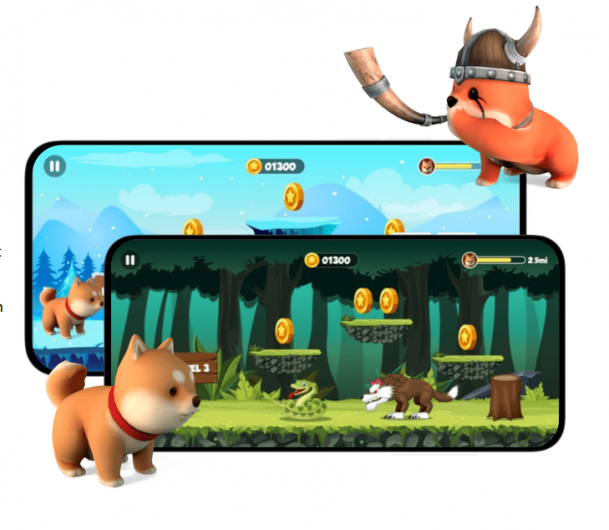According to Statista, JavaScript is the most used programming language as of 2021. Unlike other programming languages, JavaScript’s standing relies on the web development sectors and software and game development. More than that, significant universities tutor JavaScript as their primary programming language. As a result, today, many software development company use JavaScript to ensure wide-ranging application developments. Considering it’s an all-encompassing solution, it also perfectly bents on accomplishing Client-side and server-side developments too.
JavaScript has an enormous history. On top of that, a fascinating history, though. But that’s not why we’re here. We’ve pulled together the top 8 JavaScript game engines that you must know about in this blog. Not to mention untold mobile game development company/developers consume them to develop outstanding games.
Let’s get right to it!
Top 8 JavaScript Game Engines
1 – PixiJS
When it comes to the fastest 2D rendering library with blatant flexibility, PixiJS comes in very handy. PixiJS lets you develop interactive, visually delightful graphics easily. On top of that, it’s a cross-platform library, supporting wide-ranging applications. As a result, PixiJS provides a better way to harness the potential of hardware acceleration even amid lacking knowledge of WebGL. However, this JavaScript game engine has no palpable constraints as it’s an open-source tool out there and has an immense user community.
Top Bits:
- Fast
- Flexible
- Free
2 – Phaser
This is another splashing library from the top shelves of JavaScript Game Engines. Same as the PixiJS, Phaser too has sweeping features. Even better, it uses both JavaScript rendering APIs, WebGL, and Canvas to perform better. And, Phaser automatically swaps between those two JavaScript renderers when needed. More importantly, this framework has a vast community directing it towards more growth. Phaser community claims it to be a prolific, friendly, and overwhelming JavaScript game engine that widely serves diverse game development ranges. Furthermore, it’s the most liked game framework on the popular online developers’ corner – GitHub.
Apex:
- Large Plugin Support
- Huge Community
- Fast, Easy, Free
3 – Babylon JS
Among all that we’ve just shared, Babylon JS is unbelievably effective. More than that, it’s straightforward and a vibrant JavaScript rendering engine. What’s better? It lets programmers develop a distinctive wide-ranging sort of game. And that includes interactive 3d games in addition to animated logos. Apart from that, it ideally put up with creating influential games. It’s not precisely for that purpose, though. What better purpose it serves is explicitly in the game visualization. Likewise, it has a strong developers’ online community out there.
Key Points:
- Powerful
- Easy to Use
- Encompass Wide-ranging Features
4 – PlayCanvas WebGL Game Engine
PlayCanvas is a fantastic tool, especially for collaborative development, since this has a chatting feature while ensuring communication. Super handy, isn’t it? Moreover, PlayCanvas helps fast load time development through script concatenation, minification, and delayed loading time to trivial factors – that’s how it caters to fast development. On top of that, using this JS game engine can significantly eliminate the need for plugins. It just does that thru using HTML5 and WebGL. That entails using this library solely for most development steps, from writing code to testing. What’s more? PlayCanvas is an openly secured tool under the MIT license.
Foremost Views:
- Mobile Browser Supportive
- Fast Load Time
- Built For Teams Development
5 – Melon JS
Unlike the libraries we have discussed so far, Melon JS is a beginner-friendly one. In other words, it’s easy to learn for those developers who want to use it promptly. Melon JS is an HTML5 game engine that propels content as its focal point. With Melon JS comes plenty of pioneering features and third-party tools within. On top of that, Melon JS is a lightweight tool, consuming fewer computing processors while maintaining your PC’s top speed. Plus, Melon JS is an open-source library. It has ensured a plugin-free environment in addition to the write-once and run-everywhere approach, Melon JS.
High Spots:
- Beginner-Friendly
- Open-Source
- Low CPU Requirement – lightweight
6 – GDevelop
Moving on to our next best JavaScript Game Engine, GDevelop. Same as prior ones, GDevelop’s features are great plenty. GDevelop is a feature-rich game engine while mainly focuses on 2D game development, although you can develop any game with this. What’s better of GDevelop than other game engines is that it holds an Event feature. And what Event does, actually? The Event helps build game logic, especially when you have no prior knowledge of any specific programming language. Plus, games which are built on GDevelop are multi-platforms supportive. Platforms such as Web, Android, iOS, macOS, Linus, Windows, etc. Arguably all that, in a single click.
Key Stuff:
- Event Feature
- Super-Fast
- Feature-Rich
Can You Build Games with HTML5?
The answer would be, of course, you can. But, meanwhile, most game developers devote their efforts to definite game development while not in the whole abstraction layer. To that end, we would undoubtedly vouch for HTML5 game development through HTML frameworks since HTML5 game tools and frameworks embody such high-end and leading-edge elements that are highly used to build awesome games. But, more than that, myriad web games are made using HTML5. And so can you, to develop your own game.
7 – Kiwi JS
Too often, developers call this JavaScript Game Engine “WordPress of HTML5 Game Engine.” Since it’s fun and exceptionally easy to use. We’re bound to use simple and powerful tools for our great conveniences. In the world of game development, Kiwi JS is undoubtedly a tool that lives up to its name – easy and straightforward. This JavaScript Game Engine mainly focuses on accelerated WebGL rendering. Besides, it uses the Cocoon JS library for deploying games as native apps via smartphones. With Kiwi JS, you can impound physics to ensure multi-functional games.
Starring:
- Flexible Game Objects
- 2D Canvas and WebGL Rendering
- Easy to Use
8 – Three JS
Almost many times, Three JS is bafflingly absorbed as WebGL. On the other hand, this library uses WebGL for easier use. When it comes to low nuggets of coding via WebGL, Three JS truly comes into the picture by disregarding long coding bits. WebGL via Three JS can be handy to do anything useful, such as scenes, shadows, light, materials, 3d math, and others. What’s more? It is an open-source JS framework and supports Canvas2D, CSS3D, and SVG JavaScript renderers.
Wrap Up
As far as the number of JavaScript Game Engines are concerned, they’re a great many, although we’ve highlighted the top 8 of them. Game development is arguably a gigantic sector and encompasses untold tools and frameworks. Not to mention plenty of tools along with other essential components are required to build an excellent game. If you want to learn more about it, consult the best game development company today.
Additionally, be it building games or regular apps, JavaScript caters to all of them, majorly with ease. Provided that, JavaScript has a magnitude of tools and frameworks that makes each sort of development possible.





